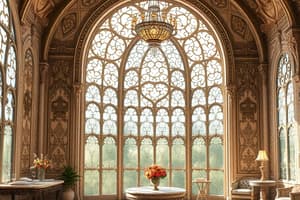Podcast
Questions and Answers
What are the objectives of a building?
What are the objectives of a building?
- To manage energy consumption
- To create shelter from the climate (correct)
- To enhance thermal comfort (correct)
- To provide aesthetic value
What is the optimal core temperature the human body seeks to maintain?
What is the optimal core temperature the human body seeks to maintain?
37°C
The skin sensors activate when the skin temperature exceeds 34°C.
The skin sensors activate when the skin temperature exceeds 34°C.
False (B)
The unit of measurement for body heat production is called _____ (MET).
The unit of measurement for body heat production is called _____ (MET).
Which of the following is NOT a goal during the facility design process?
Which of the following is NOT a goal during the facility design process?
What is the process of heat transfer through a solid material due to temperature difference called?
What is the process of heat transfer through a solid material due to temperature difference called?
What does the rate of flow of heat in the English system of units express in?
What does the rate of flow of heat in the English system of units express in?
Flashcards are hidden until you start studying
Study Notes
Objectives of a Building
- Buildings provide shelter, facilitate human activities, and enhance thermal comfort.
- These objectives are influenced by the interaction between occupants, building design, and climate.
Importance of Indoor Environmental Quality
- Building design should prioritize indoor environmental quality.
- This includes factors like thermal comfort, ventilation, material selection, noise control, odor management, energy efficiency, and lighting.
The Human Body and Thermal Regulation
- The human body has a temperature regulatory system that maintains a core temperature of 37°C.
- Key sensors include the hypothalamus (heat sensor) and skin (cold sensor).
- These sensors trigger responses to maintain thermal balance.
- It takes time for the body to adjust its core temperature.
Metabolism and Heat Production
- The human body generates heat through metabolism, converting food into energy.
- The metabolic rate, and therefore heat production, varies based on activity level.
- One MET (metabolic equivalent) represents the energy produced by a sedentary person (18.4 Btu/h/ft2 or 58.2 W/m2).
- An average adult produces approximately 360 Btu/h (106 W) of heat.
Thermal Comfort and Heat Balance
- Maintaining thermal comfort requires balancing the body's heat production with heat loss.
- This involves achieving a specific combination of skin and core temperature.
Heat Transfer
- Heat is a form of energy that flows from a higher temperature to a lower temperature.
- The British thermal unit (Btu) measures heat energy.
- Heat transfer is the process of energy transfer through a medium due to temperature difference.
- There are three main modes of heat transfer: conduction, convection, and radiation, and one thermal process that involves heat loss only: evaporation.
Conduction
- Conduction involves direct heat transfer between molecules within or between materials.
- This occurs when there is a temperature difference between the two sides of a material.
Studying That Suits You
Use AI to generate personalized quizzes and flashcards to suit your learning preferences.




